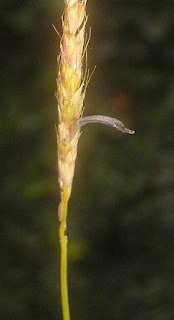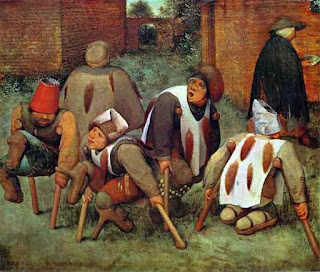Gaston and his son built a hospital near the Church of St. Anthony at Saint-Didier de la Mothe, which was administered by the new order, the Hospital Brothers of St. Anthony. It was dedicated to caring for victims of St. Anthony's fire, which was the cause of frequent epidemics.*
The Hospital Brothers were laymen, and though they cared for the poor and sick who came to visit the shrine with relics of St. Anthony at the nearby church, they did not always get along with the community of Benedictines who tended the church and shrine.
The Hospital Brothers wore black with a a blue Tau ("T") cross. The Tau cross was affiliated with St. Anthony, but we are not sure why. He was not executed on one, as some suggest (he died in his bed). One theory is that he had a T-shaped staff on which he would rest. The laymen eventually evolved into a monastic order with the blessing of Pope Honorius III (who also sanctioned the Dominicans) in 1218; 30 years later they adopted the Rule of St. Augustine and were declared canons regular by Pope Boniface VIII.
Now the "Antonines" were a fully-fledged "rival order" to the nearby Benedictines; each group felt they had primary responsibility for the relics of Anthony. Hostilities arose until the pope gave custody of the shrine to the Antonines and sent the Benedictines to Montmajour Abbey, 130 miles away.
The success of the hospital motivated them to expand. By the 15th century there were 370 hospitals in France, Spain, Italy, and Germany run by the Order of St. Anthony. They were caring for many illnesses, including the Black Death. Their popularity declined after the Reformation, especially when the link was discovered between St. Anthony's fire and ergot, after which incidents of the disease fell sharply. Their donations and influence dwindled, and in 1777 they were subsumed into the Knights of Malta. The last hospital, in Hochst, Germany (see illustration), was closed in 1803. In Memmingen, Germany, you can see a museum to the Order, on the site of one of their hospitals that was opened in 1214.
The man who first sanctioned the Order and called for the First Crusade, Urban II, did a lot more in his decade as pope. Let's dig into his career tomorrow.
*For those who don't like to click links, St. Anthony's fire was caused by ergotism, although some of the symptoms could also be the result of erysipelas.



